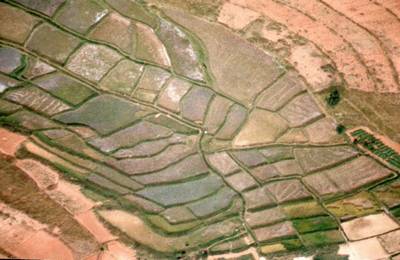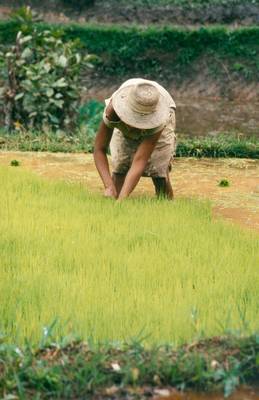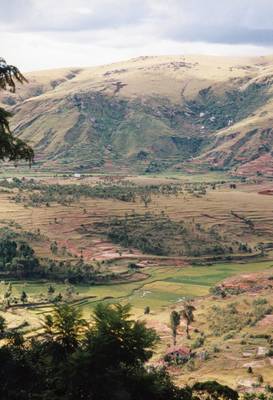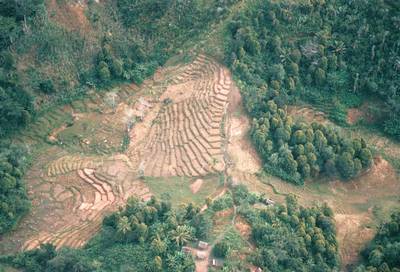
JULY 2004
The Institute of Science in Society
Science Society Sustainability http://www.i-sis.org.uk
photos from Madagascar:www.locatelli1.net/ them/brul1.shtml
Fantastic Rice Yields Fact or Fallacy?
A low-input rice cultivation system invented in Madagascar and spreading all over the world is apparently exposed as without scientific basis. Dr. Mae-Wan Ho investigates
Sources for this report are available in the ISIS members site. Full details here
Rice feeds more than half the world's
population, but yields of the crop have been levelling
out, and
400 million are said to endure chronic hunger in
rice-producing areas of Asia, Africa and South America.
According to the United Nations, demand for rice is
expected to rise by a further 38% within 30 years. To
call attention to the problem, 2004 has been declared the
International Year of Rice. "Rice is on the front
line in the fight against world hunger and poverty",
said Jacques Diouf, director-general of the UN Food and
Agriculture Organisation.
and
400 million are said to endure chronic hunger in
rice-producing areas of Asia, Africa and South America.
According to the United Nations, demand for rice is
expected to rise by a further 38% within 30 years. To
call attention to the problem, 2004 has been declared the
International Year of Rice. "Rice is on the front
line in the fight against world hunger and poverty",
said Jacques Diouf, director-general of the UN Food and
Agriculture Organisation.
Many farmers all over Asia have already identified low-input, sustainable solutions to the problem (see other articles in this series).
One simple method that boosts rice yields at much lower cost to farmers originated outside Asia. The System of Rice Intensification (SRI) developed in the late 1980s in Madagascar, has since been spreading to other parts in Africa and to Asia. In Madagascar itself, some 100 000 farmers have converted to it. And more than 20 other countries, from Bangladesh to Thailand, have either adopted SRI, or field tested it, or expressed firm interest. In Cambodia, SRI was unheard of in 2000, but by 2003, nearly 10 000 farmers had converted to it, and that figure may reach 50 000 this year.
Advocates of SRI routinely report yields up to twice or more those achieved by conventional agriculture.
However, eminent agronomists are dismissing those claims as "poor record keeping and unscientific thinking"; and results of new field trials, published in March 2004 in the journal Field Crop Research, appear to support this view.
History of SRI
SRI was developed nearly 20 years ago by Father Henri de Laulanié, a Jesuit priest who worked with farming communities in Madagascar from 1961 until his death in 1995. In conventional rice growing, the plants spend most of the season partially submerged in water. During a 1983 drought, many farmers could not flood their paddy fields, and de Laulanié noticed that the rice plants, in particular, their roots, showed unusually vigorous growth.
From this and other observations, de
Laulanié developed the SRI practice: rice seedlings are  transplanted
quickly when young, spaced widely apart, and most
importantly, the rice fields are kept moist but not
flooded. In addition, he emphasized using organic compost
over chemical fertilizers, so that poor and rich farmers
alike could practise SRI.
transplanted
quickly when young, spaced widely apart, and most
importantly, the rice fields are kept moist but not
flooded. In addition, he emphasized using organic compost
over chemical fertilizers, so that poor and rich farmers
alike could practise SRI.
Norman Uphoff, a political scientist and director of the International Institute for Food, Agriculture and Development at Cornell University in Ithaca, New York, stepped into the picture in 1993. He was part of a team trying to find alternatives to the damaging types of slash and burn agriculture that was destroying Madagascar's rainforest. It was clear to Uphoff that if rice yields in the area could be increased from about 2 tonnes per hectare, as it was then, a lot of forest could be saved. He came across de Laulanié's not-for-profit organisation, `Tefy Saina' meaning "to improve the mind".
Uphoff was looking for a yield of 4 tonnes per hectare, and when he heard them say they could get 5 or more, he did not believe them. But such doubts vanished once farmers in the rainforest regions started using SRI. The results were stunning. "By the end of the second growing season we were getting 8 tonnes per hectare". In 1997, Uphoff began promoting SRI throughout Asia.
Why SRI benefits farmers, consumers and the environment
SRI's benefits lie in important differences from conventional rice growing practice, which, proponents believe, interact synergistically to give high yields.
First, seedlings are transplanted at 8-12 days instead of 15 to 30 days after germination, singly as opposed to 2-3 seedlings, and spaced up to 6 times apart compared to traditional practice; for example, up to 50cm x 50cm instead of 20cm x 20cm. This represents a substantial saving on seeds, up to ten-fold or more in some cases. The increased spacing has the effect of encouraging tillers or side shoots to develop quickly, giving many more rice-forming panicles per plant.
Second, the fields are kept moist during all or most of the growing season instead of being flooded continuously. This tremendous saving on water is particularly important in areas of water scarcity, and avoids the damages of salination that accompanies over-irrigation. It also encourages vigorous root development, which in turn gives more vigorous growth of the rice plants.
Third, no herbicides are used. Weeding is done with or a simple rotary hoe, which returns the weeds to the soil as green manure. This financial saving is offset by increased labour, but labour shortage is seldom a problem for farmers in the Third World, and weeding becomes less arduous in successive years. Giving up herbicides is a health bonus for all concerned: the farm worker most of all, and the consumer; and there is no pollution of the environment and ground water.
Fourth, no mineral fertilizers are used, only liberal application of organic compost. This financial saving is accompanied by an improvement to the quality and fertility of soil, reducing runoff, and improving its water-retaining properties.
Despite its early start in Madagascar, SRI has only begun in other countries since 2000, and already, positive results are pouring in (see "Does SRI work?" this series).
Critical scientists
Major critics of SRI include John Sheehy, an agronomist at the International Rice Research Institute (IRRI) in Manila, the Philippines. He said most SRI field studies have appeared in conference proceedings and other publications not subject to peer review.
That is hardly surprising given the lack of interest from mainstream scientists, and its relatively recent uptake in countries other than Madagascar.
In March 2004, Sheehy, together with IRRI researcher Shaobing Peng, A. Dobermann of the University of Nebraska, Lincoln in the United States, and other researchers from Sheffield University in the UK; from Yangzhou University, Jiangsu, Hunan Agricultural University, Changsha, and Guangdong Academy of Agricultural Science, Guangdong, China, published their first trials of SRI under the telling title, "Fantastic yields in the system of rice intensification: fact or fallacy?"
This report was written up as a news feature in the top journal Nature, under the yet more telling title, "Feast or famine?" asking whether SRI was a diversion from "more promising approaches" to increasing yield such as genetic engineering.
Sheehy and coworkers planted a single rice cultivar, shanyou 63, at three experimental stations in Hunan, Guangdong and Jiangsu provinces of China, using SRI and conventional best practice in living-room-sized (8 x 5m) plots in the same fields. Weeds were suppressed with herbicides on the conventional plots but pulled by hand in the SRI plots. SRI plots received extra rapeseed cake fertilizer. Conventional plots were flooded as usual; SRI plots were kept saturated and only flooded 2 weeks before maturity.
Overall, no significant differences were found between the two cropping systems. SRI yielded 8.5% higher in Jiangsu, but 8.8% worse in Hunan.
Dobermann was reportedly "not surprised", as he said every component of SRI had been studied before and found to have little effect. The results also fit Sheehy's theoretical calculation of how much rice a field can produce, an upper limit set by the amount of sunlight falling on it. Based on weather data for Madagascar, Sheehy calculated theoretical maximum outputs for areas that have reported the most impressive yields of 21 tonnes/ha under SRI. By his estimates, the yields are as much as 10 tonnes more than is possible. "You can't get out more than gets put in," he reportedly said.
They concluded that, "SRI has no major role in improving rice production generally".
That was a remarkable sweeping
dismissal of the extensive research and trials done by
both scientists and farmers on numerous rice varieties in
19 countries over two or more growing seasons. Especially
so, when the conclusions are
based on the results of limited trials of a single
variety for only one growing season.
Riposte
Chinese scientists have experimented with SRI since 2000, and their experience had indicated that not all varieties responded to SRI, and that responses improve in successive seasons. Dobermann himself had referred to the possibility of confounding effects when SRI was compared to traditional systems that did not represent the current "best practice". Of course, what is best practice for corporate agriculture is not necessarily best practice for the farmer.
Thus, Sheehy and workers could have stressed the obvious benefits to small farmers, consumers and the environment, even from the results of their own trials. They have obtained the same yields with less than half the seeds in SRI, with no inputs of herbicides, and substantial saving on water.
Norman Uphoff pointed out, in a detailed rebuttal to appear in Field Crop Research, that Sheehy and colleagues have simply not followed the SRI practice in their trials. It did not include the measures recommended for water management and weeding to ensure active soil aeration. Moreover, the high concentrations of chemical fertilizers used with the putative SRI plots (180-240 kg N/ha) would simply have inhibited the soil activity that enhances plant nutrition and growth.
"The merits of SRI methods have been validated by scientists at leading institutions in China, India and Indonesia, the largest rice-producing countries in the world," he remarked.
Why are scientists in research stations failing to replicate the enormous yield gain with SRI methods obtained by farmers? For example, IRRI started trials with SRI at Los Baños in 2002, and obtained a yield of only 1.44t/ha; and the next season, it was still just 3t/ha. Yet, concurrent SRI trials in the government's Agricultural Training Centre in Mindanao, using three varieties (PSBRc18, 72H and 82) yielded an average of 12t/ha.
When asked by IRRI staff why this discrepancy occurred, Uphoff suggested that IRRI's on-station soils, after decades of monocropping and application of fertilizers, insecticides, fungicides, herbicides etc., might be "almost dead", and hence unable to respond to SRI practices, which depend on increasing the abundance and diversity of soil microorganisms to enhance plant growth and health.
The basis for dismissing the high
yields obtained in some parts of Madagascar as
"fallacy" is  highly questionable. It rests on a `model' for
predicting theoretical maximum yield using `constants'
derived solely from empirical observations on
conventionally grown crops, which have no independent
justification in terms of the plant's metabolism. For
example, biomass accumulation depends on the balance
between photosynthesis (which builds up biomass) and
respiration (which decreases it), and that can change
under different conditions. A healthy plant is also more
efficient in using energy and accumulating biomass than
an unhealthy one.
highly questionable. It rests on a `model' for
predicting theoretical maximum yield using `constants'
derived solely from empirical observations on
conventionally grown crops, which have no independent
justification in terms of the plant's metabolism. For
example, biomass accumulation depends on the balance
between photosynthesis (which builds up biomass) and
respiration (which decreases it), and that can change
under different conditions. A healthy plant is also more
efficient in using energy and accumulating biomass than
an unhealthy one.
An indication that yields more than 20 tonnes/ha may not be "impossible" is that such yields have been recorded for rice growing systems in China in historical times.
Professor Yuan Longping, an expert in breeding high-yielding hybrid rice, who brought SRI to China, stated, "According to the estimates of most plant physiologists, rice can use about 5% of solar energy through photosynthesis. Even if this figure is discounted by 50%, the yield potential of rice would be as high as 22- 23t/ha in temperate regions."
Uphoff maintained that the critics' assumptions are too firmly rooted in conventional practice. Models for estimating maximum yields will not necessarily translate to SRI. "The coefficients for the calculations are based on plants with stunted root systems. SRI plants have extensive root systems," he said.
Nor will single-season trials reveal the full potential of SRI, because over time, better oxygenation leads to the build-up of soil bacteria that interact with the roots and improve the condition of the soil. Even if SRI fails to increase yields when first introduced, as was the case in Thailand, for example, further seasons will see it come into its own.
Proponents insist that SRI is popular because it really increases yields impressively. T.H. Thiyagarajan, dean of the Agricultural College and Research Institute in Killikulam, India, rejects criticisms of individual aspects of SRI. In combination, he says, the whole is greater than the sum of its parts. "The synergistic effect of all these components is the crucial thing." He helped convince the Tamil Nadu state government to spend US$50 000 to promote SRI to local farmers.
In fact, the individual components have been tested in Madagascar and other countries, and each component was found to increase yield. The one that appeared to give the most increase was transplanting younger seedlings. But this practice is more challenging for inexperienced farmers used to handling sturdier older seedlings.
New evidence
Norman Uphoff's weighty response drew attention to new evidence from scientists in China (see "Does SRI work?" this series), Indonesia and India. SRI evaluations were started in Tamil Nadu Agricultural University in India in 2001, and by 2003, it had demonstrated such improvements in yield and profitability that the state government provided $50 000 for spreading SRI practice. About half the rice crop in the Cauvery Delta, the main rice-producing area of Tamil Nadu, will be given over to SRI cultivation; the farmers are so impressed with the size of the harvest and cost savings, including water, over the past two years.
While Sheehy and coworkers reported that SRI crops took 2 weeks longer to mature, that was most likely due to the soil not being well drained and aerated. When properly managed, crops mature more quickly under SRI. In Andhra Pradesh SRI crops matured 10 days earlier, while in Cambodia, they ripened about one week before the conventional crops.
The claim that SRI gave no advantage compared with "best practice" or officially recommended improved cultivation methods is also refuted. In Nepal, farmers compared SRI with their own usual practices and `improved' practice. In 2002, the average SRI yield of 8.07t/ha was 37% higher than the average with improved practices, and 85% higher than the average with farmers' practices.
A. Satyanarayana, rice geneticist responsible for introducing SRI in the Indian state of Andhra Pradesh since the summer season of 2003, responded to Nature's news feature by pointing out that, "The experiences of farmers are quite different from what is reported by sceptical scientists."
More importantly, the costs of SRI are low and its potential productivity very high, which is "more important than ever now that the Green Revolution technologies are showing signs of fatigue."
He gave further evidence that SRI
definitely works for Andhra Pradesh farmers and called on
scientists to collaborate constructively with farmers
(see "Top Indian plant geneticist rebuts SRI
critics", this series)
.
| This article can be found on the I-SIS website at http://www.i- sis.org.uk/RiceWars.php |